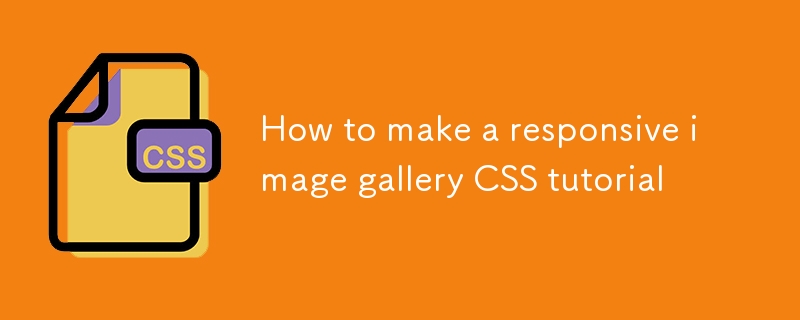Found a total of 10000 related content

Mastering CSS Grid for Complex Web Layouts
Article Introduction:CSSGridrevolutionizesweblayoutbyenablingprecise,responsive,andcomplexdesignswithminimalcode.1.Defineagridcontainerwithdisplay:gridandusegrid-template-columns,grid-template-rows,andgaptostructurelayout,leveragingfr,minmax(),andrepeat()forflexibility.2
2025-07-25
comment 0
667

React/Tailwind template with default responsive NavBar.
Article Introduction:I was just annoyed with excluding App.test.js and all those default files that I would not use in my React project, and also I've never found a good navbar other than that free version of navbar from Tailwind UI website, which is not the best navbar
2024-11-16
comment 0
1185

Bootstrap Navbar: does it work with legacy browsers?
Article Introduction:BootstrapNavbar is compatible with most older browsers, but it depends on the browser version. Bootstrap5 does not support IE10 or below. Bootstrap4 needs to add polyfills and custom CSS to be compatible with IE9. Bootstrap3 supports IE8, but sacrifices modern functions. Compatibility issues focus mainly on CSS, JavaScript and responsive design.
2025-06-18
comment 0
360

Edu-Tech Platform: A Cutting-Edge Digital College Website Template
Article Introduction:This is a submission for the Wix Studio Challenge: Community Edition.
My Community Platform
Introducing Edu-Tech Platform—a fully responsive, cleanly designed digital college template tailored for educational institutions that aim to prov
2024-11-01
comment 0
694

What is ref in Vue 3?
Article Introduction:ref is used to create responsive references, and must first give a clear answer: ref is the core function used in Vue3Composition API to create responsive references, suitable for managing responsive state and DOM references; ① Use ref() to make basic type values or objects responsive, and they need to be read and written through .value; ② Automatically unpack in the template without .value; ③ It can be used to obtain DOM elements or child components instances, and accessed through .value after mounting; ④ Working in conjunction with reactive, computed and other APIs, it is the preferred way to implement responsiveness in setup().
2025-08-01
comment 0
499

How to implement complex grid layouts using CSS Grid?
Article Introduction:The methods to implement complex grid layout using CSSGrid include: 1. Define the basic grid structure and use display:grid and grid-template-columns/rows. 2. Use grid-template-areas and grid-area to allocate elements to the specified area. 3. Use media queries to realize responsive design. 4. Control grid project alignment and spacing through justify-items, align-items and other properties.
2025-05-20
comment 0
404

How to create a card layout with CSS?
Article Introduction:To create a responsive CSS card layout, first build the card structure using HTML, then beautify the style with CSS, and implement a responsive grid via Grid or Flexbox. 1. Each card consists of a div containing pictures, content and buttons; 2. Use border, box-shadow, border-radius and other attributes to design the card appearance to ensure the image is responsive; 3. Use CSSGrid to set.card-grid to display:grid, use grid-template-columns:repeat(auto-fit,minmax(280px,1fr)) to achieve adaptive column count, or use Flexbo
2025-08-05
comment 0
739

How to create a grid in CSS?
Article Introduction:To define a grid container, you need to set display:grid; 2. Use grid-template-columns and grid-template-rows to set the row and column size; 3. Use fr, auto, % and other flexible units to achieve responsive layout; 4. Use repeat() function to simplify repeated column or row definitions; 5. Use minmax() and auto-fit/auto-fill to achieve adaptive grids; 6. Optionally, precisely control project location through grid-column, grid-row or grid-area; complete settings include container declaration, track definition, gap addition and responsive optimization, so that efficient and flexible two-dimensional layout can be built.
2025-07-28
comment 0
175

How to debug a Vue application?
Article Introduction:The core of debugging Vue applications is to master tools and mechanisms. 1. Use VueDevtools to view component tree, props, responsive data and track component relationships; 2. Combine console.log and debugger positioning logic issues; 3. Check template binding and responsive updates, pay attention to using $set and mutation methods; 4. Cooperate with ESLint and unit tests to prevent errors. Understanding Vue's operating mechanism and rationally utilizing tools can effectively improve debugging efficiency.
2025-07-30
comment 0
856

What is the role of reactivity transform in Vue 3?
Article Introduction:Vue3's responsive conversion simplifies the use of responsive data by automatically unpacking refs. 1. It allows direct use of ref variables in contexts such as template expressions, watch, and computed without the need for .value; 2. After enabling this feature, the deconstructed defineProps() value remains responsive; 3. Applicable only to environments configured with and specific build tool; 4. Not applicable to non-primitive values such as objects or arrays. This feature reduces redundant code and improves the development experience, but may reduce code clarity. Whether it is enabled depends on project requirements and team preferences.
2025-07-21
comment 0
801

CSS Grid layout tutorial explained
Article Introduction:CSSGrid is a powerful 2D web layout tool suitable for handling complex page structures. 1. Defining the Grid container requires display:grid; 2. Using grid-template-columns and grid-template-rows to set the column and row size; 3. Position sub-items through grid-column and grid-row or span keywords; 4. Using grid-template-areas to name areas to simplify complex layout; 5. Use gap attributes to control spacing; 6. Automatically add new rows through grid-auto-rows; 7. Cooperate with media queries to realize responsive adjustments, mastering these key points can efficiently build modern
2025-07-01
comment 0
727

How does template compilation work in Vue?
Article Introduction:Vue's template compilation mechanism converts HTML-style templates into efficient JavaScript rendering functions, which are divided into three steps: 1. Template parsing: parsing template strings into abstract syntax trees (ASTs), structured representations of tags, attributes and interpolated expressions; 2. AST conversion: insert responsive logic, handles instructions and dynamic bindings, so that the views can be automatically updated when data changes; 3. Generate render function: finally compiled into a browser-executable JavaScript function, which is completed during the construction stage or runtime, ensuring efficient rendering and updating of pages.
2025-06-29
comment 0
488

How to make a responsive image gallery CSS tutorial
Article Introduction:The key to responsive picture gallery is to use the right CSS layout and styling skills. First, use Flexbox or Grid layout, where Grid is more suitable for multi-column responsive gallery, and automatically arranges by setting .gallery{display:grid;grid-template-columns:repeat(auto-fit,minmax(200px,1fr));gap:1rem;}; secondly, ensure the image is adaptable, maintain the proportion and fill the container through img{max-width:100%;height:auto;display:block;}; thirdly, add hover effects such as magnification and shadow
2025-07-02
comment 0
458

How to define a reactive property in Vue 3 setup?
Article Introduction:In Vue3's setup() function, defining responsive properties is mainly implemented through ref and reactive. 1. Use ref to create responsive properties of basic types. You need to operate the data through .value and automatically unpack it in the template; 2. Use reactive to create responsive properties of objects or arrays, and directly access the properties without .value; 3. Select ref to be suitable for basic types or scenarios where responsiveness is required, and select reactive to be suitable for objects or arrays and you want the attribute to access more natural; 4. You can combine toRefs to avoid destroying responsiveness, and understanding the difference between the two is the key.
2025-07-02
comment 0
716

What is CSS Grid Layout?
Article Introduction:CSSGrid is a two-dimensional web layout tool that allows developers to accurately control the position and size of page elements by defining rows and columns. Unlike Flexbox, it can handle rows and columns simultaneously, suitable for building complex structures. To use Grid, you must first set the container to display:grid, and define the row and column size through 1.grid-template-columns and 2.grid-template-rows, set the spacing, and 4.grid-template-areas named area to improve readability. Its typical application scenarios include responsive layouts, dashboard interfaces, and picture galleries. Practical tips include: 5. Use grid-column/g
2025-06-23
comment 0
357

What are the core differences between Vue.js and React in componentized development?
Article Introduction:The core differences between Vue.js and React in component development are: 1) Vue.js uses template syntax and option API, while React uses JSX and functional components; 2) Vue.js uses responsive systems, React uses immutable data and virtual DOM; 3) Vue.js provides multiple life cycle hooks, while React uses more useEffect hooks.
2025-05-21
comment 0
758

How does Vue data binding work
Article Introduction:Vue realizes responsive binding through data hijacking combined with publish subscription mode. 1. Use Object.defineProperty (Vue2) or Proxy (Vue3) to hijack data during initialization, and properties can be traced when they are accessed or modified; 2. The template is compiled into a rendering function to generate a virtual DOM; 3. Updates are triggered when data changes, and DOM operations are optimized through asynchronous queues; 4. There are special restrictions on the responsive processing of arrays and objects, and specific methods are required to ensure responsiveness.
2025-07-08
comment 0
816

The Complete Guide to CSS Grid Layout
Article Introduction:To master CSSGrid, first use display:grid to create a grid container, and use grid-template-columns/rows to define row and column sizes, supporting fr, auto and fixed values; 2. Use gap to set grid spacing to avoid using margin; 3. Use grid-column/row or grid-area to accurately place projects, and use grid-template-areas named areas to improve readability; 4. Use repeat(auto-fit, minmax(250px, 1fr)) to achieve responsive column adaptation; 5. Master justify-content/align-co
2025-07-31
comment 0
353

How to handle forms in Angular
Article Introduction:Template-driven forms are suitable for simple scenarios, and form state is processed through ngModel and instructions; responsive forms are suitable for complex controls, and models are manually built through FormControl and FormGroup; verification can be implemented through built-in rules or custom functions; performance-oriented, lazy loading, sharing state, abstract components, and using patchValue.
2025-06-25
comment 0
336



















